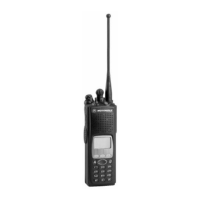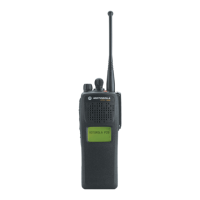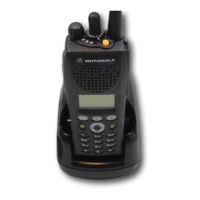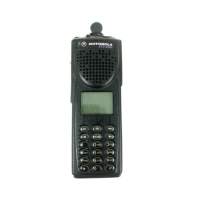Do you have a question about the Motorola XTS-5000 and is the answer not in the manual?
Method to organize channels and talkgroups specific to an agency's radio. Custom for every agency.
Contains radio frequencies, talkgroups, and configuration for a radio, including controls like knobs and menus.
Standardized Codeplug Policy that allows for cloning and minimizes radio programming time.
Users can only talk when their channel is clear of traffic.
Trunking allows many talkgroups to utilize a limited number of repeaters.
Radio affiliates one talkgroup with one site; the site authorizes radio use on the system.
Details on scanning conventional systems by changing frequencies and trunked systems by monitoring control channels.
Identifies the concentric switch, select knob, power/volume control, toggle switch, and top button.
Describes the Push-to-Talk (PTT) button and other side buttons.
Explains menu items, zone number, radio ID, home key, and navigation keys.
Explains symbols for call reception, signal strength, battery, talkaround, monitor, and secure/clear operation.
Details the meaning of Red and Green LED lights indicating transmitting, busy channels, or incoming calls.
Instructions for installing and removing the radio's antenna.
Procedures for attaching and detaching the radio battery.
Steps for removing and installing the universal connector cover.
Instructions for connecting and disconnecting the speaker/microphone accessory.
Steps for attaching and detaching the belt clip to the battery.
Guide on using the On/Off/Volume Control to power the radio up and down.
Procedures for navigating menus to select zones and using the knob for channel/mode selection.
Steps for initiating a transmission, listening, and receiving calls.
How to override coded squelch (PL/DPL) for conventional and trunking operations.
Instructions for selecting secure or clear transmission modes using the concentric switch.
Procedure for requesting AES encryption keys manually over the air.
Steps for initiating an emergency call and exiting the emergency state.
How to view the current site or force the radio to search for a new site in trunking mode.
Guide to editing, changing, and saving the time and date settings on the radio.
Protocol for reporting missing radios containing sensitive information and remote disabling.
Method to organize channels and talkgroups specific to an agency's radio. Custom for every agency.
Contains radio frequencies, talkgroups, and configuration for a radio, including controls like knobs and menus.
Standardized Codeplug Policy that allows for cloning and minimizes radio programming time.
Users can only talk when their channel is clear of traffic.
Trunking allows many talkgroups to utilize a limited number of repeaters.
Radio affiliates one talkgroup with one site; the site authorizes radio use on the system.
Details on scanning conventional systems by changing frequencies and trunked systems by monitoring control channels.
Identifies the concentric switch, select knob, power/volume control, toggle switch, and top button.
Describes the Push-to-Talk (PTT) button and other side buttons.
Explains menu items, zone number, radio ID, home key, and navigation keys.
Explains symbols for call reception, signal strength, battery, talkaround, monitor, and secure/clear operation.
Details the meaning of Red and Green LED lights indicating transmitting, busy channels, or incoming calls.
Instructions for installing and removing the radio's antenna.
Procedures for attaching and detaching the radio battery.
Steps for removing and installing the universal connector cover.
Instructions for connecting and disconnecting the speaker/microphone accessory.
Steps for attaching and detaching the belt clip to the battery.
Guide on using the On/Off/Volume Control to power the radio up and down.
Procedures for navigating menus to select zones and using the knob for channel/mode selection.
Steps for initiating a transmission, listening, and receiving calls.
How to override coded squelch (PL/DPL) for conventional and trunking operations.
Instructions for selecting secure or clear transmission modes using the concentric switch.
Procedure for requesting AES encryption keys manually over the air.
Steps for initiating an emergency call and exiting the emergency state.
How to view the current site or force the radio to search for a new site in trunking mode.
Guide to editing, changing, and saving the time and date settings on the radio.
Protocol for reporting missing radios containing sensitive information and remote disabling.
| Display | Alphanumeric LCD |
|---|---|
| Modes | Analog, Digital (P25) |
| Battery Type | NiMH, Li-Ion |
| GPS | Optional |
| Frequency Range | 136-174 MHz, 380-470 MHz, 700/800 MHz |
| Channels | Up to 1, 000 channels |
| Encryption | DES, AES |
| Operating Temperature | -22°F to +140°F (-30°C to +60°C) |
| Battery Life | 8-12 hours (depending on battery type and usage) |











